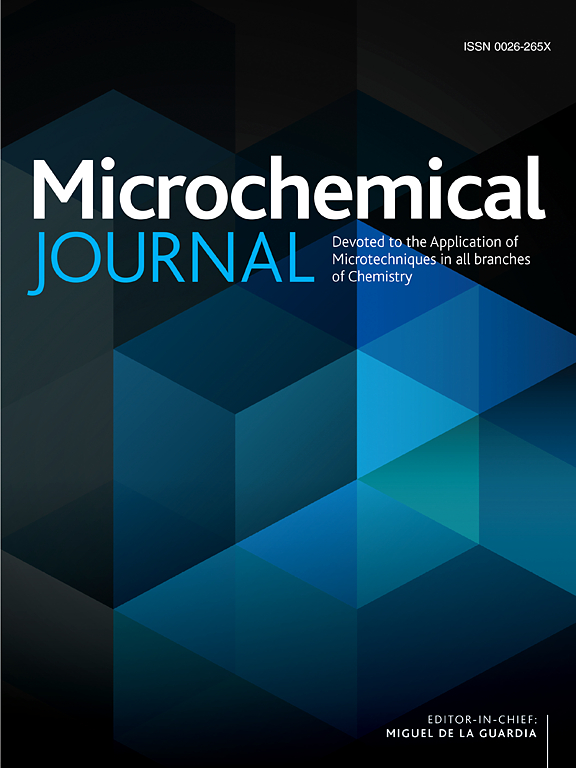Effect of optimisations on CNN performance in identifying adulteration of red chilli powder
IF 4.9
2区 化学
Q1 CHEMISTRY, ANALYTICAL
引用次数: 0
Abstract
This study presents a deep learning framework for the detection and classification of adulteration in Red Chilli Powder using image-based analysis. Besides the aim is to analyse the effect of various optimisation techniques to balance the classification performance of the DenseNet models. Hence, two architectures, DenseNet-121 and DenseNet-169, were optimised using three optimisers (namely AdamClr, RMSprop, and AdamW) across three batch sizes (i.e., 16, 32, 64) over 150 epochs. Further, the performance of the models was analysed on two custom datasets: one for binary classification (pure vs. adulterated RcP) and the second for multiclass classification, identifying six natural adulterants at concentration levels 5%, 10% and 15%. The performance was evaluated using standard metrics derived from confusion matrices, while Gradient-weighted Class Activation Mapping visualisations enhanced model interpretability. The DenseNet-169 combined with AdamClr optimizer at batch size 32 achieved the highest binary classification accuracy (98.92 %) and robust convergence. In multiclass classification, the same configuration demonstrated superior generalisation (accuracy: 96.73%). AdamClr consistently outperformed RMSprop and AdamW, offering stability, rapid convergence, and resilience across datasets. RMSprop exhibited batch size sensitivity and instability, while AdamW, delivered occasional competitive results but lacked robustness without meticulous hyperparameter tuning. Overall, the results highlight the critical role of dynamic learning rate strategies and model depth in optimising convolution neural networks performance for food adulteration detection. This framework demonstrates strong potential for real-world applications in spice authentication and food quality assurance.

优化对CNN识别红辣椒粉掺假性能的影响
本研究提出了一个深度学习框架,用于使用基于图像的分析来检测和分类红辣椒粉中的掺假。此外,目的是分析各种优化技术的效果,以平衡DenseNet模型的分类性能。因此,两个架构,DenseNet-121和DenseNet-169,使用三个优化器(即AdamClr, RMSprop和AdamW)在三个批大小(即16,32,64)超过150个epoch进行优化。此外,在两个自定义数据集上分析了模型的性能:一个用于二元分类(纯RcP与掺假RcP),第二个用于多类分类,确定了浓度水平为5%,10%和15%的六种天然掺假物。使用来自混淆矩阵的标准度量来评估性能,而梯度加权类激活映射可视化增强了模型的可解释性。在批量大小为32的情况下,DenseNet-169与AdamClr优化器结合获得了最高的二值分类准确率(98.92%)和鲁棒性收敛。在多类分类中,相同的配置表现出更好的泛化性(准确率:96.73%)。AdamClr始终优于RMSprop和AdamW,提供跨数据集的稳定性、快速收敛和弹性。RMSprop表现出批量大小的敏感性和不稳定性,而AdamW偶尔会产生竞争结果,但缺乏鲁棒性,没有细致的超参数调整。总体而言,结果突出了动态学习率策略和模型深度在优化卷积神经网络性能用于食品掺假检测中的关键作用。该框架在香料认证和食品质量保证方面具有强大的实际应用潜力。
本文章由计算机程序翻译,如有差异,请以英文原文为准。
求助全文
约1分钟内获得全文
求助全文
来源期刊

Microchemical Journal
化学-分析化学
CiteScore
8.70
自引率
8.30%
发文量
1131
审稿时长
1.9 months
期刊介绍:
The Microchemical Journal is a peer reviewed journal devoted to all aspects and phases of analytical chemistry and chemical analysis. The Microchemical Journal publishes articles which are at the forefront of modern analytical chemistry and cover innovations in the techniques to the finest possible limits. This includes fundamental aspects, instrumentation, new developments, innovative and novel methods and applications including environmental and clinical field.
Traditional classical analytical methods such as spectrophotometry and titrimetry as well as established instrumentation methods such as flame and graphite furnace atomic absorption spectrometry, gas chromatography, and modified glassy or carbon electrode electrochemical methods will be considered, provided they show significant improvements and novelty compared to the established methods.
 求助内容:
求助内容: 应助结果提醒方式:
应助结果提醒方式:


